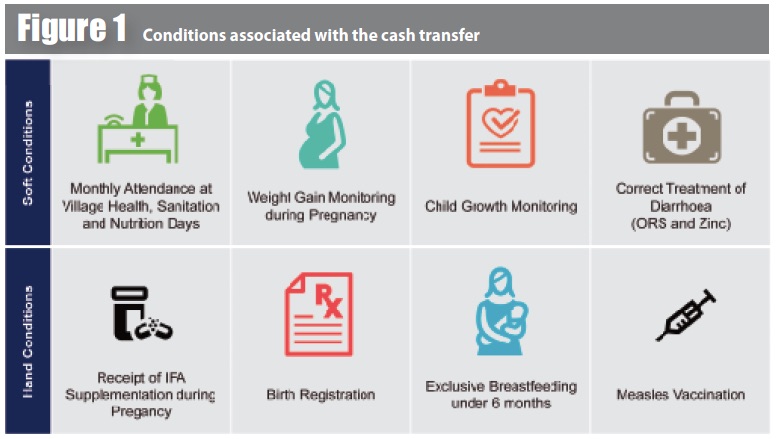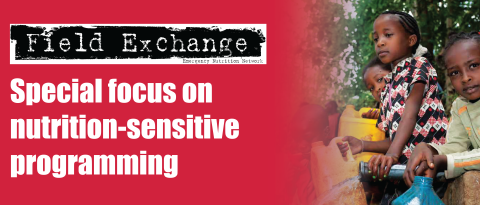Cash, food or vouchers? Evidence from a randomised experiment in northern Ecuador
Summary of research1
Location: Northern Ecuador
What we know: There is ongoing debate on the most effective form of food assistance: cash, food vouchers or food transfers.
What this article adds: A prospective randomised control trial (RCT) investigated the dietary impact and cost-effectiveness of cash, food vouchers and food transfers in refugee and host urban communities in northern Ecuador. Six transfers at monthly intervals over six months were made. In this context, all three modalities significantly improved the quantity and quality of food consumed: food transfers led to significantly larger increase in calories consumed; vouchers led to a significantly larger increase in dietary diversity; cash transfers increased food consumption. Food transfers were the least cost-effective modality of improving any outcome measure; vouchers were the most cost-effective means of increasing dietary diversity or caloric intake, though least preferred by beneficiaries; and cash was the cheapest way to improve welfare. Choice of assistance type depends on policy objectives.
Assistance in the form of cash is justified primarily on the grounds that it generates the largest welfare gains, as it allows beneficiaries to use these transfers as they see fit. Near-cash transfers, such as food vouchers and in-kind transfers, have the theoretical advantage that only those truly in need will take them up. Other arguments in favour of one form of transfer over another are circumstance-dependent. For example, the injection of cash into a local economy may cause food prices to rise and therefore have an adverse impact on non-beneficiaries living in the same locality. Despite ongoing debate on the most effective form of food assistance, little rigorous evidence exists that compares food assistance in the form of cash versus in-kind. This paper aims to add to the evidence base through the use of a randomised evaluation to assess the impacts and cost-effectiveness of cash, food vouchers and food transfers on the quantity and quality of food consumed in communities in northern Ecuador.
Responding to a request from the Government of Ecuador in April 2011, the World Food Programme (WFP) expanded its assistance to address the food security and nutrition needs of Colombian refugees and to support their integration into Ecuadorian communities. The new programme was designed as a prospective RCT and consisted of six transfers at monthly intervals of cash, food vouchers or food transfers to Colombian refugees and poor Ecuadorian households. The objectives of the programme were threefold: to improve food consumption by facilitating access to more nutritious foods; increase the role of women in household decision-making related to food consumption; and reduce tensions between Colombian refugees and host Ecuadorian populations. The programme was implemented in seven urban centres in the provinces of Carchi and Sucumbíos. Participating households received benefits from April 2011 to September 2011. The value of the monthly transfer was standardised across all treatment arms at US$40 per month per household. Nutrition sensitisation was a key component of the programme, aimed at influencing behaviour change and increasing knowledge of recipient households, especially with regard to dietary diversity. To ensure a consistent approach to knowledge transfer, a curriculum was developed by WFP to be covered at each monthly training.
The programme evaluation was based on random assignment. Randomisation was conducted in two stages: first, neighbourhoods were randomised to either the treatment group or the control group; second, all treatment clusters (geographical units within neighbourhoods) were randomised to cash, food voucher or food transfer. The baseline survey was conducted from March to April 2011 before the first transfers were distributed. The follow-up survey was conducted approximately seven months later (October to November 2011), after the last of the six transfer distributions. In total, the baseline sample for the evaluation consisted of 2,357 households, of whom 2,122 were resurveyed at follow-up. Outcome indicators included household food consumption, based on the consumption of 41 food items seven days prior to the survey; caloric intake, calculated from the amount of food consumed by households multiplied by the energy value for each item; and dietary quality, measured using the dietary diversity index (DDI), household dietary diversity score (HDDS) and the food consumption score (FCS). To reduce the probability that impact estimates were confounded by differences in programme design, careful attention was paid to ensure that all aspects of the transfer programme, including transfer levels, transfer frequency and conditions attached to programme participation, were as similar as possible across modalities.
Results show that all three treatment arms significantly improve the quantity and quality of food consumed as measured by the values of food consumption, per capita caloric intake and dietary diversity measures. The authors found no differences across treatment arms in the amount of the transfer that was used on food versus non-food expenditures. However, there were significant differences in the types of food consumed. In particular, food transfers led to a significantly higher increase in calories, while vouchers led to significantly larger improvements in dietary diversity. When food consumption was broken down into food groups, underlying patterns explaining these differences emerge. The larger increase in calories from the food arm is mainly due to significantly larger increases in consumption of cereals, which represent 41% of a household’s caloric intake. The larger increase in dietary diversity from the voucher arm is mainly due to significantly larger increases in the number of days households consume vegetables, eggs, milk and dairy. These differences indicate that transfers of equivalent value and frequency are used differently on food. While food transfers increase food consumption, the increase is concentrated mainly on the food items that make up the food basket. Cash and vouchers also increase food consumption, but are used on food items that have fewer calories compared to the food items from the food transfer. The difference in food consumption between cash and vouchers is more subtle and most likely due to the limits placed on vouchers toward nutritious food and to flyers on how to spend the vouchers that were posted on supermarket windows. Differences in types of food available at the supermarkets versus central markets may be another reason for the differences in food consumption between cash and voucher recipients.
Differences across treatment arms also emerge in terms of impacts on the poorest households compared to the better off. In particular, food led to significantly larger improvements for the poorest households compared to the wealthiest. On the other hand, cash and vouchers led to similar impacts across the wealth distribution. Consequently, food is more targeted to the poorest households and leads to larger increases in the value of food consumption and caloric intake than vouchers.
Costs were also analysed. The authors found that the marginal cost is US$11.50 to provide a food transfer, US$3.03 to provide a cash transfer, and US$3.30 to provide a voucher. Given these costs and impacts, food is the least cost-effective means of improving all food consumption and dietary diversity outcomes. The direct comparison of cash versus vouchers is not as straightforward and ultimately depends on the specific objectives of policymakers. If the objective is to increase the value of food consumption, there is no difference between cash or food vouchers. However, if the objective is to increase dietary diversity or caloric intake, vouchers are more cost-effective than cash.
The authors caution that the findings are specific to urban populations with well-functioning markets and supermarkets; they may not hold in areas where supermarkets lack capacity to cater for more clients or lack a consistent supply of various food items. Moreover, the caloric intake of the targeted population is relatively high and not as vulnerable to weather shocks. Thus, the way in which beneficiaries spend the transfer may be different from that of populations with low food-energy consumption or populations whose food-energy consumption is more vulnerable to weather shocks, such as rural farmers.
 In the context considered here, selecting the most appropriate form of assistance depends on the objectives of the policymakers. If the objective of these transfers is simply to improve welfare, cash is preferable, as the modality that beneficiaries are most satisfied with and as the cheapest option. Given the budget available to WFP for this project, shifting from food to cash could have increased the number of beneficiaries by 12%. Moreover, cash allows for savings, which helps households smooth their food and non-food consumption. If the objective is to increase calories or dietary diversity, vouchers are the most cost-effective means of doing so, followed by cash. Although the voucher modality is the most cost-effective means of increasing caloric availability and dietary quality, it is the modality least preferred by beneficiaries. Thus, policymakers are faced with the trade-off of improving overall welfare or improving specific outcomes. The former gives recipients autonomy, while the latter restricts their choices in order to achieve specific objectives.
In the context considered here, selecting the most appropriate form of assistance depends on the objectives of the policymakers. If the objective of these transfers is simply to improve welfare, cash is preferable, as the modality that beneficiaries are most satisfied with and as the cheapest option. Given the budget available to WFP for this project, shifting from food to cash could have increased the number of beneficiaries by 12%. Moreover, cash allows for savings, which helps households smooth their food and non-food consumption. If the objective is to increase calories or dietary diversity, vouchers are the most cost-effective means of doing so, followed by cash. Although the voucher modality is the most cost-effective means of increasing caloric availability and dietary quality, it is the modality least preferred by beneficiaries. Thus, policymakers are faced with the trade-off of improving overall welfare or improving specific outcomes. The former gives recipients autonomy, while the latter restricts their choices in order to achieve specific objectives.
In conclusion, the authors state that all three treatment arms significantly improve the quantity and quality of food consumed as measured by the values of per capita food consumption, per capita caloric intake, and dietary diversity measures. Moreover, there is no evidence of increases in non-food expenditures. However, across treatment arms, differences emerge in the types of food consumed, with food transfers leading to a significantly larger increase in calories consumed and vouchers leading to a significantly larger increase in dietary diversity. Combining impact estimates with costing data, the authors conclude that, given the significantly higher costs of implementing food transfers, food is always the least cost-effective modality of improving any outcome measure, and vouchers are usually the most cost-effective.
Footnotes
1 Hidrobo, M., Hoddinott, J., Peterman, A., Margolies, A and Moreira, V. (2012). Cash, food or vouchers? Evidence from a randomized experiment in Northern Ecuador. IFPRI Discussion Paper No. 01234. Available at SSRN: http://ssrn.com/abstract=2197461 or http://dx.doi.org/10.2139/ssrn.2197461


